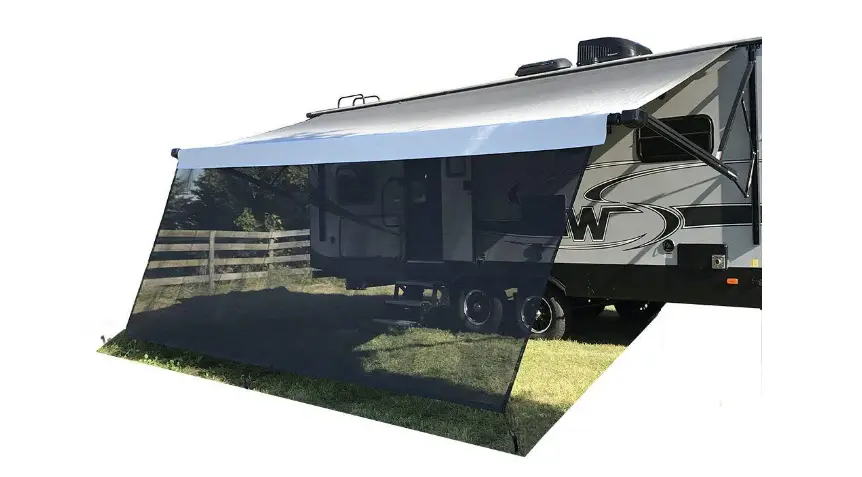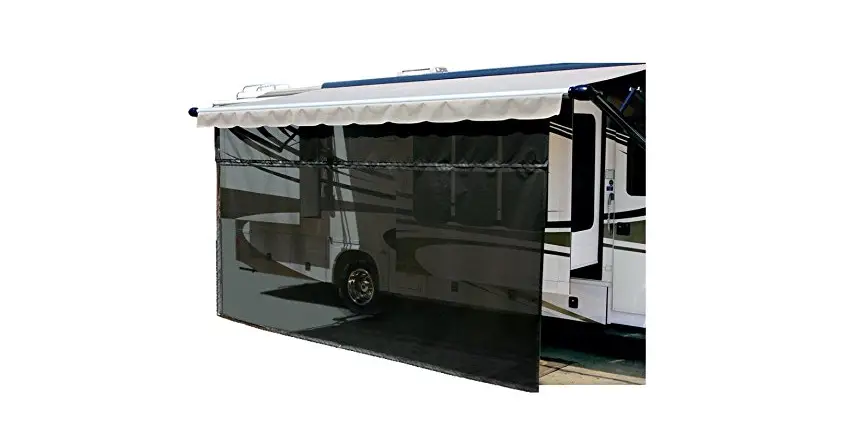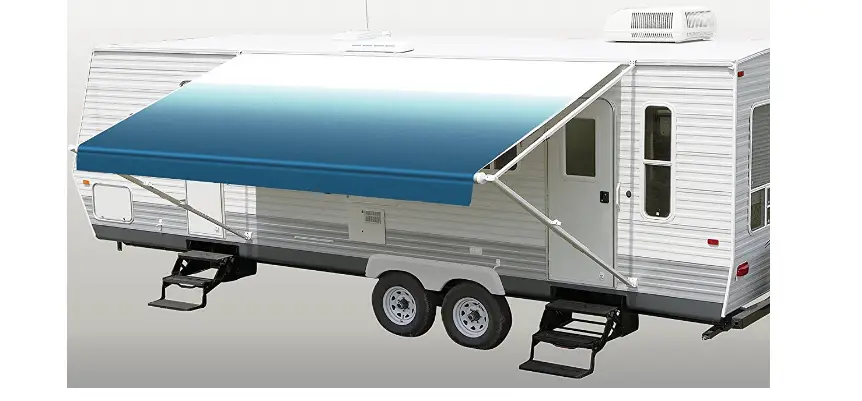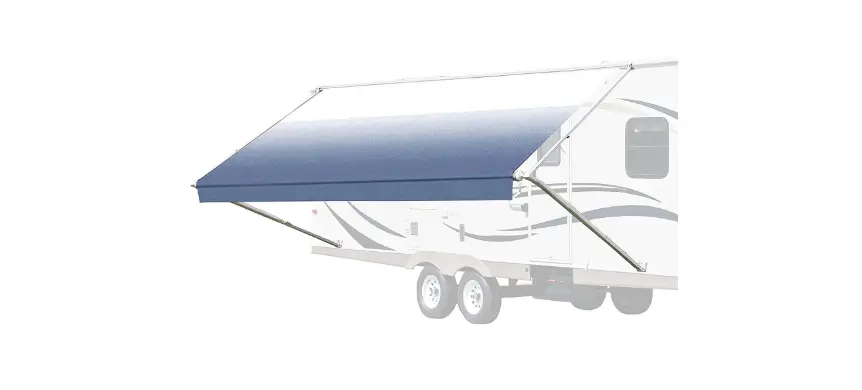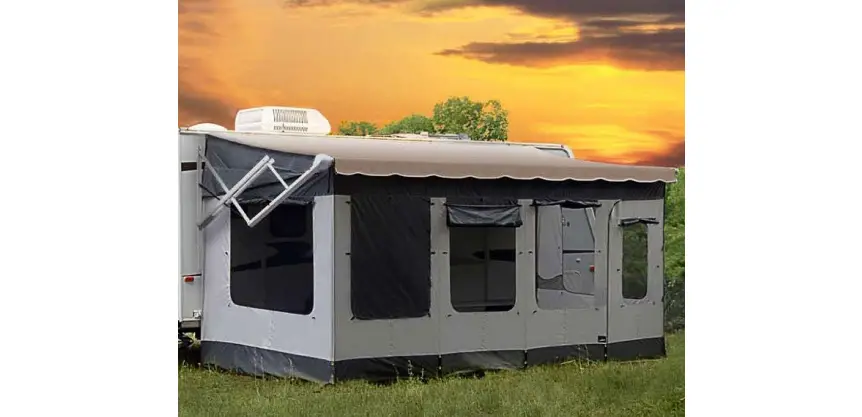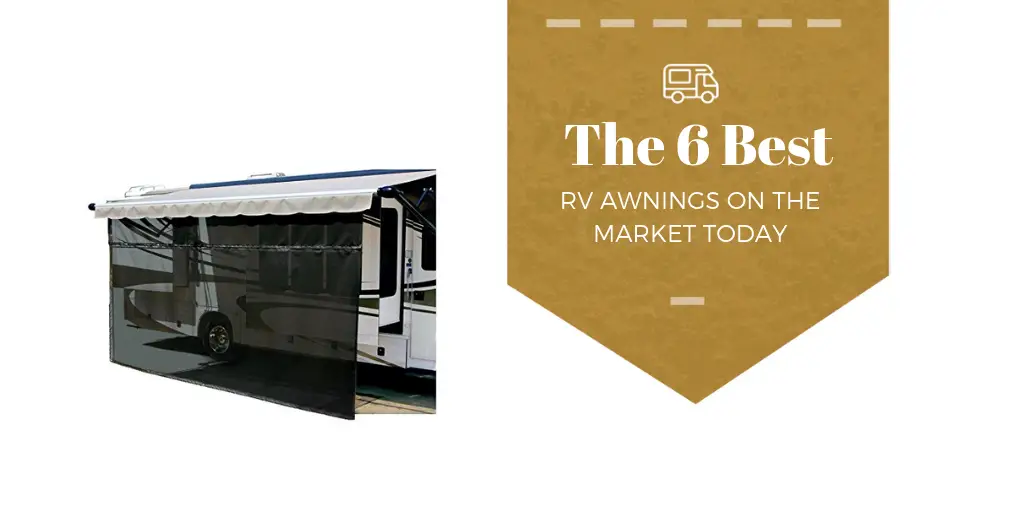
6 Best RV Awnings on the Market Today
An RV awning is the retractable piece of fabric that often hangs off the side of an RV, supported by metallic arms and frames. They extend usable space and provide shade under which you can sit while sipping coffee or reading the papers.
An RV awning is either a roof or cover that can be used to provide additional shelter from the sun, rain or even some mild wind. Some of them can be retracted while some are stationary, and they’re made of materials like vinyl, acrylic, aluminum, etc.
However, the awnings that come with RVs are often of inferior quality and don’t last very long. If your current RV awning is damaged, or if you simply want an upgrade, you should look out for the best RV awnings on the market today.
In this article, I reviewed some of my favorite RV awnings in a fair and unbiased manner.
There are a number of benefits of using an RV awning:
- You can increase the space available around your RV.
- It can provide shelter from wind, sun, or rain.
- If you want to sit outside the RV, without being exposed to the sun, you can sit under the awning as you enjoy coffee or read a book.
- If you get a screen type awning, it can serve as a shelter from bugs and other insects.
- Screened rooms can also provide you additional privacy as they serves independent rooms.
Types of RV awnings are determined by how they are positioned, where they are located, and whether they are retractable. The most common are retractable, shade, canopy, shelter and screen room type.
Table of Contents
Best Shade, Canopy and Shelter Awnings for RVs
A shade awning is simply a canopy that can be attached along the side of the RV to provide shade on summer days. They’re easy to install and can be combined with drop-down mesh sun panels to provide additional shade.
Canopy
Canopies are similar to shade, only a lot more durable and made of tougher materials. In addition to offering shade under the sun, they can protect you from rain and strong winds.
Shelter
Shelters serve the same function as shades and canopies, but they’re made of tougher fiberglass material or plastic and are used to provide protection for the entire RV. They can withstand most external elements. However, they’re also heavy and difficult to both install and disassemble.
1. Tentproinc RV Awning
This is a mesh sun shade awning by Tentproinc meant largely for use on hot summer days to provide protection from UV rays and wind. It can be attached to your existing awning, so it drops down from the edge of the awning and can be hooked to the ground, creating a cool screen for you.
The mesh quality is strong and durable, so you don’t need to worry about the mesh tearing or ripping when you hook it to the ground. The company also claims that it can block out 86% of UV rays while not restricting visibility. I cannot comment on their claims; however, I can attest to the fact that it kept me cool and out of direct sunlight while my visibility was not restricted in any way.
The only issue I have is that it doesn’t come with mesh sides. You have the mesh screen, but the sides are left uncovered. If you’re camping at night and want to use it to keep bugs out, you’ll have to purchase the sides separately. This felt a bit like a cash grab to me, and I don’t appreciate it. In my view, the mesh sides should have been a part of the package.
You should carefully measure the width of your RV before purchasing. Fortunately, it is available in a number of different colors and sizes, so you’ll find one that suits your RV without difficulty.
This RV awning shade comes in a single piece, and there’s no zip attached. You have to slide the 3/16” PVC cord into the awning track. It’s also very easy to slide it out and roll up the fabric.
There have been some complaints from users about the fact that this shade doesn’t ensure privacy. However, I find this to be unjustified because the manufacturer has clearly stated that it’s not meant for privacy and it retains visibility. It’s made of mesh material, after all. As such, if you need a shade that provides privacy, you should find another type of RV awning.
Pros
- Strong visibility.
- Lightweight and durable mesh.
- Easy to attach and install.
Cons
- Doesn’t come with sides.
- Cannot stand independently. Has to be used in combination with an existing awning.
2. Carefree 701508
The Carefree 701508 is yet another awning shade meant to be used in combination with an existing RV awning. Like the Tentproinc RV Awning, this too is meant for those who want protection from harsh sun rays and a cooler space for relaxing.
It differs from the Tentproinc in its visibility. The material used — vinyl-coated polyester — is a lot thicker than the mesh used in the Tentproinc. As such, you have a lot more privacy. This can be a good or bad thing depending on your needs. Some people prefer to experience the awning’s cooling effects without losing visibility. If so, this is not the right shade for them. However, if you want the shade to provide you with some privacy while you relax, this is meant for you. You should note, however, that it provides relative privacy. It’s dark and dense, so people won’t be able to see you clearly, but dark silhouettes will still be visible.
It comes in two parts — a lower skirt and an upper zippered insert panel. The two parts need to be attached using a zipper that runs through the middle. The upper part needs to be attached to the existing awning and the lower part is then staked to the ground. The zippered insert needs to be attached to the free slot of the awning roller and can be used to roll up the awning.
This method also allows you to reach it without using a ladder; you simply have to zip the body panel into the awning’s insert. All the tools you need for installation — bag, spikes, and tie downs — are available with the product, so you don’t need any additional purchases.
Like the Tentproinc, I was again disappointed that the manufacturer doesn’t provide awning sides. If they designed another shade, I would prefer they provide shades on all sides, not just one. This product doesn’t even provide side shades you can purchase externally.
Pros
- Block out UV rays and provide shade.
- Ideal for hot summers.
- Durable material.
- Privacy provided.
Cons
- Installation is complex.
- Side shades are not available.
Best Retractable RV Awnings
As the name suggests, retractable RV awnings can be collapsed, folded, and stored right in the RV. This is useful whenever you’re traveling, so the extended awning doesn’t present an obstacle. It only takes a few minutes to install, so that shouldn’t be an issue.
Retractable awnings come with metallic arms that can be folded without entirely collapsing or removing the awning. These are available in mechanical and electric variants. The mechanical awnings require a crank to be opened or closed while the electric models can simply be opened or closed by pressing a button.
The mechanical variant is easier to install and has fewer parts. The electric variant is a lot more convenient, but it’s also more difficult to install.
3. SunWave Awning Fabric Ocean Blue Fade
The SunWave Awning Fabric Ocean Blue Fade is a highly durable and waterproof vinyl retractable RV awning. As the name suggests, it’s available in a faded blue shade and is made of a durable 15 oz vinyl material with an additional 16 oz vinyl weather shield. This ensures that no water is absorbed by the material, and it provides protection from sun, wind, and rains. Since it is just an overhead RV awning, it cannot provide protection from bugs or allow for privacy, but you can attach a separate shade to block out bugs as well.
This is a manually operated retractable RV awning. As such, you’ll have to install and take it off manually. If you’re experienced, you’ll be able to do it pretty easily. With the help of a friend, you can install the awning within a few minutes without much of a hassle, if you know what you’re doing. However, if you’ve never installed such an awning before, you’ll find it quite challenging. For one, threading the second groove is difficult because of the lack of a pre-sewn seam.
This awning comes with a sewn-in poly cord next to the valance and around the side of the RV. However, the poly cord that comes with the fabric isn’t sewn in, so you’ll have to insert it by threading it through the material, which is quite a hassle.
Furthermore, while it’s possible to install the awning on your own, you will pretty much have to rely on instinct and YouTube tutorials as the instructions manual is a mess and leaves you more confused than clarified.
Pros
- Aesthetically pleasing design.
- Lightweight and durable.
Cons
- Confusing instructions.
- Difficult installation process.
4. ALEKO RVAW16X8BLUE24
The ALEKO RVAW16X8BLUE24 is a manually-operated retractable RV awning. It can be opened and closed with a simple hand crank in less than a minute. It’s made of acrylic material and, as such, it’s water-resistant but not waterproof.
This means that it will prevent water accumulation and water will easily evaporate; however, if you touch the underside of the awning, you will feel its wetness. However, it’s mildew resistant so you don’t have to worry about mold growth if it remains damp for too long. It also provides protection from the sun and complete UV protection.
The kit comes with all of the tools necessary for installation, including arms and rails. I was disappointed that the instruction manual was so poorly written and even carried a lot of simple spelling and grammatical errors. It seemed like the person who wrote it didn’t really even understand what he was writing, which made it incredibly difficult to follow. I had to eventually rely on a mixture of common sense and online tutorials from other users to install it. Once I got a hang of it, the installation was fairly simple.
The roller is provided in three separate pieces, so you have to put them together. However, once you do, it’s pretty strong. You also have to manually thread the spline through the top of the fabric, another complicated step. Besides these two minor inconveniences, the rest is quite easily handled, especially the arm lock, which I loved.
All things considered, this is one of the best retractable RV awnings on the market, as long as you have the time to figure out the installation carefully.
Pros
- Durable material.
- UV, mildew, and water resistant.
- Hand crank makes it easy to open and close.
- All necessary tools are provided with the product.
Cons
- The instruction manual is a complete mess.
Best Screen Room RV Awnings
A screen room is essentially an additional room with four walls and a roof that you can attach beside your RV. It expands your RVs available space while providing you with another room where you can enjoy some privacy and be protected from the external elements.
5. Carefree 291800 Vacatione’r Screen Room
The Carefree 291800 Vacation’r is the best screen room to extend your RV’s surface area. It’s available in a range of sizes from 86 to 150 inches, and is easily be attached next to an RV for some privacy. It’s made of a durable yet lightweight material. There are several mesh windows attached on the walls of this screen room, but they can be covered up using the drop-down extension, thus providing complete privacy.
It comes with a skirt to ensure it’s fully enclosed, down to the last inch. If you have pets or kids, you’ll have keep down the skirt firmly, so they cannot get out from underneath. This screen room can be used independently or in combination with an existing awning if you prefer to use it as the roof.
The doors on this screen room come with a zip, so you’ll have to zip and unzip your way in and out of the door. This can be a nuisance to handle. Furthermore, zipper doors aren’t very durable. After a few months of continuous use, it’s inevitable that some of the zips give away, and you’ll have to find a replacement. I would have preferred magnetic screen doors or even Velcro strips instead of zip, as they flap shut behind you instantly. If necessary, you can purchase a magnetic net door separately.
If it’s windy, you should take down the screen room completely because it will flap around quite a lot, and the zippers and windows can get damaged. However, disassembling it doesn’t take too long.
Pros
- Easy installation.
- Complete privacy.
- Works with other awnings as well.
- An additional extension panel is available if you need to extend the size for a perfect fit.
- Can keep out the sun, rain, and bugs.
Cons
- Zipper doors can be difficult to use and aren’t durable.
- Not ideal for windy days.
6. Dometic 935002.120 Veranda Room
The Dometic 935002.120 Veranda Room is a screen room available in a 7’ to 12’ length and can be attached to both manually-operated or electrical awnings. However, it’s necessary to already have an awning in place, as it doesn’t have a roof of its own. This is perhaps one of the cheapest screen rooms on the market and it’s a great way to increase your RV’s living space, while also ensuring protection from UV rays and bugs.
The walls of this screen room are made entirely of mesh, so it cannot offer privacy the way most screen rooms can. This one can offer you protection from UV rays and bugs when camping, but not privacy. The fabric, however, is fire-resistant, dries easily and is resistant to mildew. Having said that, since it’s made of mesh; it cannot keep rain out. As such, if the weather is windy or if you’re expecting rain, you should take it down.
It comes with a trailer skirt which can be staked down to the ground, so there’s no space left at the bottom of the screen room. However, the top is attached to the awning via a Velcro strip. It’s easy to install but Velcro can easily come off if there’s the slightest wind. Furthermore, Velcro isn’t a very durable material and its efficiency decreases over time.
Pros
- Can be attached to all awnings.
- Provides protection from UV rays and bugs.
- Fire and mildew resistant.
- Dries quickly.
- Easy to install.
Cons
- Cannot withstand the slightest of winds or rain.
- Velcro strip for attachment isn’t durable.
- It’s necessary to already have an awning in place.
- No privacy as the mesh is partially transparent.
FAQ About RV Awnings
Factors to Consider when Buying an RV Awning
The following are some of the most important factors you need to take into consideration when buying an RV awning.
Fabric/ Material
RV awnings are made of a number of different materials such as canvas, acrylic, vinyl, fiberglass, plastic, among others. The material will determine the amount of protection it offers, weight, durability, etc.
For example, if you’re traveling during the summer, you might need a lightweight material that can offer protection from the sun. However, if you’re traveling during windy or rainy months, you will need stronger protection.
The following are the most popular materials used for RV awnings.
Acrylic
Acrylic is a breathable fabric made of individual threads that have been woven together. The fact that it’s made of individual woven threads means that air can circulate through it, ensuring that it’s cool during the hot months. It is available in a lot of different colors and design options, and it doesn’t fade because it’s made with colored threads rather than dying the material later.
Acrylic fabric is water-repellent, so water will either roll off the surface or eventually evaporate. However, it’s not waterproof, so it will get wet and you can feel the wetness and moisture on the awning’s underside. It can provide protection from both sun and rain, but not if the rain is heavy.
Vinyl
Vinyl fabrics are a lot more durable than acrylics and consist of four layers — a top layer resistant to fading, a painted vinyl layer, a polyester layer to add strength and durability, and a base layer to offer support.
Vinyl fabrics are completely waterproof and extremely durable. However, it’s important to dry them out before storage or they will develop mold and mildew. They’re great for locations with high rainfall, but not in places that are constantly humid.
Installation Process
Some awnings can be installed within a few minutes, and some require a complicated set of instructions that take hours. You should go for an RV awning that’s easy to install individually within a few minutes.
RV Measurements
This is a most crucial factor. RVs are available in all sizes, and so are their awnings. You need to find an RV awning meant for your RV size, neither too big nor too small. You should ask the RV awning’s manufacturer about the RVs its meant for. Or if you want to measure yourself, go for an RV awning that’s 1/2 or 1/3 times the length of your RV.
Personal Needs
You need to consider where you plan to go with your RV. If you travel to locations without electric outlets, getting an electrical RV awning will be a bad idea. In this case, you would want a lightweight and durable manually-handled RV awning. However, if you spend most of your time in camping grounds with a power supply, you can get an electrical awning even if it’s heavier.
Aesthetics
This is the least practical factor. However, since you’ll be using an RV awning for a long time, make sure the print and color is one you enjoy looking at.
How to Make Sure Your RV Awning is Waterproof?
Whether your RV awning is waterproof will depend on the material. The most waterproof fabric is vinyl fabric, as it’s essentially a laminated piece of cloth. This prevents water from seeping through, making it completely waterproof.
How to Attach an Awning to your RV?
Electric awnings should ideally be installed by professionals. As such, I’ll tell you how to install a manual RV awning. Before you start, you’ll need another individual’s help and two step ladders, so you can support the awning on both sides.
Once everything is in place, follow these steps:
- Attach the awning rail to the correct spot using screws and bolts.
- Pull the awning tube towards yourself and unroll the awning carefully.
- Slide the upper awning arms into their position and use the tension knobs to adjust the tension and fix them firmly in place.
- Depending on the type of awning, the bottom support arms will either be placed on the ground or on the sides of the RV.
How to Open, Close, or Repair an RV Awning?
In this section, I’ll show you how to open, close, repair, or replace an RV awning.
Opening an RV Awning
- Squeeze the release mechanisms at the side of the arms to unlock them.
- Set loose the rafter knobs and place the ratchet mechanism in a roll-down position. In some cases, the sliding mechanism can be handled remotely. This will release the awning.
- Use the pull-down strap loop and pull rod to extend the awning and slide the arms upwards.
- Secure the awning by drawing the awning tube while pushing it down gently.
- Tighten the knob on both tension arms.
- Use the lift handle to disengage the catch pin, move it up, and pull the awning to extend it completely.
- To prevent water accumulation, place one end of the awning about 3 inches below the other corner to create a slope from which water can slide down.
Closing an RV Awning
- Lower the arms of the awning using the pull-down straps.
- Loosen the rafter knobs and rafter catches from the back of the arms.
- Set the rafters in a rest position to ensure that the awning doesn’t roll up automatically. Hold the awning rod and strap in place when loosening the rafters.
- Use the switch at the top to put the ratchet mechanism on roll-up mode.
- Wind up the awning by connecting the hook to the pull strap.
- Secure the travel locks and make sure the handle releases are locked.
- Secure the rafter knobs to prevent the awning from opening up again.
Repairing an RV Awning
- Use a non-abrasive cleaner to clean the top and bottom parts of the damaged location on the awning.
- Dry the awning using an absorbent towel.
- Patch the damaged area using a clear repair tape. Make sure the angle is correct and even out any air bubbles that might form.
- Repeat the process for all the tears, both for the top and bottom parts of the awning.
How to heat an RV Awning?
The only type of RV awning that can be heated is a screen room. You can create a screen room next to your RV, and since it is essentially an enclosed space, you can also install a heater. Once you do that, you can open and close the RV door at will without fear that the cold air will get in.
Conclusion
I hope this article has helped you figure out which is the best RV awning on the market. And I hope I’ve been able to answer all your questions about their use. So now that you’ve made up your mind, it’s time to extend that shade and enjoy!



